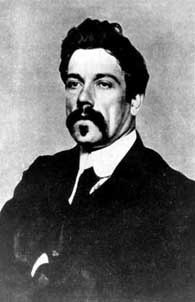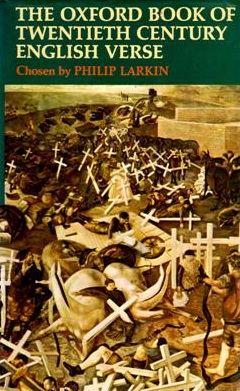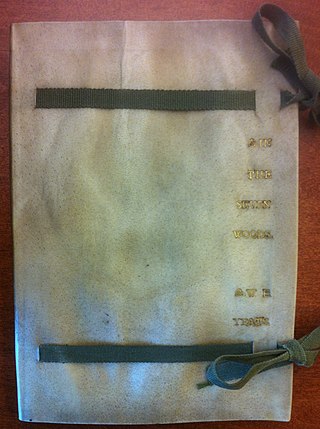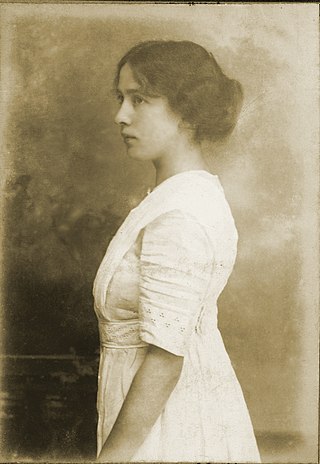
John Butler Yeats was an Irish artist and the father of W. B. Yeats, Lily Yeats, Elizabeth Corbett "Lolly" Yeats and Jack Butler Yeats. The National Gallery of Ireland holds a number of his portraits in oil and works on paper, including one of his portraits of his son William, painted in 1900. His portrait of John O'Leary (1904) is considered his masterpiece.

Edmund John Millington Synge was an Irish playwright, poet, writer, collector of folklore, and a key figure in the Irish Literary Revival. His best-known play The Playboy of the Western World was poorly received, due to its bleak ending, depiction of Irish peasants, and idealisation of patricide, leading to hostile audience reactions and riots in Dublin during its opening run at the Abbey Theatre, which he had co-founded with W. B. Yeats and Lady Gregory. His other major works include In the Shadow of the Glen (1903), Riders to the Sea (1904), The Well of the Saints (1905), and The Tinker's Wedding (1909).

George William Russell, who wrote with the pseudonym Æ, was an Irish writer, editor, critic, poet, painter and Irish nationalist. He was also a writer on mysticism, and a central figure in the group of devotees of theosophy which met in Dublin for many years.

The Oxford Book of Twentieth Century English Verse is a poetry anthology edited by Philip Larkin. It was published in 1973 by Oxford University Press with ISBN 0-19-812137-7. Larkin writes in the short preface that the selection is wide rather than deep; and also notes that for the post-1914 period it is more a collection of poems, than of poets. The remit was limited by him to poets with a period of residence in the British Isles. Larkin's generous selection of Thomas Hardy's poems has been noted for its influence on Hardy's later reputation. On the other hand, he was criticized, notably by Donald Davie, for his inclusion of "pop" poets such as Brian Patten. The volume contains works by 207 poets.
The Irish Literary Revival was a flowering of Irish literary talent in the late 19th and early 20th century. It includes works of poetry, music, art, and literature.

Padraic Colum was an Irish poet, novelist, dramatist, biographer, playwright, children's author and collector of folklore. He was one of the leading figures of the Irish Literary Revival.

Katharine Tynan was an Irish writer, known mainly for her novels and poetry. After her marriage in 1893 to the Trinity College scholar, writer and barrister Henry Albert Hinkson (1865–1919) she usually wrote under the name Katharine Tynan Hinkson, or variations thereof. Tynan's younger sister Nora Tynan O'Mahony was also a poet and one of her three children, Pamela Hinkson (1900–1982), was also known as a writer. The Katharine Tynan Road in Belgard, Tallaght is named after her.

Elizabeth Corbet Yeats, known as Lolly, was an Irish educator and publisher. She worked as an art teacher and published several books on art, and was a founder of Dun Emer Press which published several works by her brother W. B. Yeats. She was the first commercial printer in Ireland to work exclusively with hand presses.

The Dun Emer Press was an Irish private press founded in 1902 by Evelyn Gleeson, Elizabeth Yeats and her brother William Butler Yeats, part of the Celtic Revival. It was named after the legendary Emer and evolved into the Cuala Press.

Susan Mary Yeats, known as Lily Yeats, was an embroiderer associated with the Celtic Revival. In 1908 she founded the embroidery department of Cuala Industries, with which she was involved until its dissolution in 1931. She is known for her embroidered pictures.
Events in the year 1903 in Ireland.
Anne Butler Yeats was an Irish painter, costume and stage designer.

In the Seven Woods: Being Poems Chiefly of the Irish Heroic Age is a volume of poems by W. B. Yeats, published in 1903 by Elizabeth Yeats's Dun Emer Press, the first edited by this publishing house.
William Monk Gibbon was an Irish poet and prolific writer, known as "The Grand Old Man of Irish Letters". His collection of over twenty volumes of poetry, autobiography, travel and criticism are kept at Queen's University Belfast. The Monk Gibbon fonds are kept at the University Archives, Queen's University at Kingston. The material consists of correspondence, drafts of his books, poems, photographs and news clippings. Correspondents include W. B. Yeats, other members of the Yeats family, George William Russell (A.E.), George Moore, John Eglinton and Padraic Colum. He also wrote many published novels, and has been characterised as "self-regarding and prickly".
This is a list of all works by Irish poet and dramatist W. B. Yeats (1865–1939), winner of the 1923 Nobel Prize in Literature and a major figure in 20th-century literature. Works sometimes appear twice if parts of new editions or significantly revised. Posthumous editions are also included if they are the first publication of a new or significantly revised work. Years are linked to corresponding "year in poetry" articles for works of poetry, and "year in literature" articles for other works.

Máire ‘Mollie’ Gill (1891–1977) was a political activist who became third and longest-serving president of the Camogie Association and captained a Dublin team to an All Ireland championship while serving as president of the association.

Evelyn Gleeson was an English embroidery, carpet, and tapestry designer, who along with Elizabeth and Lily Yeats established the Dun Emer Press.
William Kirkpatrick Magee, was an Irish author, editor, and librarian, who as an essayist and poet adopted the pen-name of John Eglinton. He became head librarian of the National Library of Ireland, after opposing the "cultural nationalism" of his time. From 1904 to 1905 he edited the literary journal Dana and was the biographer of George William Russell ("Æ").
Kitty MacCormack was an Irish designer with the Dun Emer Guild, theatre set designer, actress and author.
The Dun Emer Guild (1902–1964) was an Irish Arts and Crafts textile studio founded in 1902 by Evelyn Gleeson, initially in partnership with Elizabeth and Lily Yeats as Dun Emer Industries and Press.












